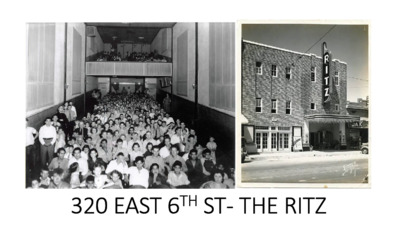C.3.1 - 320 E 6th St - Plans — original pdf
Backup

320 EAST 6TH ST- THE RITZ The Ritz was built in 1929 by J.J. Hegman, who owned several movie theaters in Austin, Texas. It was the first theater in Austin to be built specifically for the talkies. The architect was Hugo Kuehne, the founding dean of the University of Texas School of Architecture, who also designed the Austin History Center (originally the Austin Public Library). The Ritz was originally a long narrow space, and was segregated like most movie theaters in Texas and other southern states at that time; there was a separate entrance leading to a balcony reserved for people of color.[1] The theater opened on 6th Street on October 13, 1929. It showed primarily first-run westerns with a lower ticket price than any other theater in town and frequently brought in stars like Wild Bill Elliott and Dub Taylor, along with country music acts who performed before the movies.[2] In 1937, Hegman's son Elmo took over management and expanded the theater to 800 seats by widening the theater by 25 feet. He continued showing Westerns until television siphoned off the audience; Elmo closed the theater in 1964.[1] Cary White, the production designer for The Faculty and Spy Kids, amongst other movies, was the projectionist and janitor at the Ritz during some of its last days as a movie house.[3] The theater remained shuttered until 1970, when it re-opened for three years as an adult theater. In October 1974, entrepreneurs Jim Franklin (artist) and Bill Livinggood renovated the theater and opened the doors as a music venue, offering an eclectic mix of programming from classical to rock and including live theater and movies. This was also short-lived, and the club closed in 1975.[4] Several other groups moved in over the years. The Center Stage theater group took it over in 1977, closing off the balcony to make a second, separate theater. Again, the venue didn't last long and the late 1970s saw a serious decline in the theater's fortunes, including another stint into porn exhibition.[5] In 1981, Shannon Sedwick and Michael Shelton took out a lease and turned management over to Craig Underwood, who began running the venue as a punk rock club. Shows such as Black Flag, which inaugurated the punk era on May 7, 1982, The Misfits, Hüsker Dü, The Circle Jerks, The Dead Kennedys, Minor Threat and others showed that there was an audience for hardcore and opened the doors for an influx of punk rock into the Austin music scene. The violence inherent to punk rock shows eventually cost the operators their liquor license, forcing another closure in late 1982. In fall 1983, Sedwick and Shelton relocated their successful Esther's Follies, a comedy troupe that still entertains Austin just a few blocks further east on 6th St. Esther's Follies was only one of the attractions hosted by the Ritz at that time. The managers also began reintroducing music, from Texas bands to heavy metal, and very cautiously brought back a little bit of punk rock.The most famous show played at The Ritz in the eighties was the Red Hot Chili Peppers November 23 show there in 1986.[1] The building has consistently been a music venue, bar, and pool hall since that time. On March 20, 2007, the Alamo Drafthouse Cinema announced that they would be relocating their downtown cinema, which was the original theater opened in 1997, to the Ritz. They began construction on April 1, 2007 to revive the Ritz as a movie theater.[6] During renovation, a group of filmmakers from Fantastic Fest were given a tour of the construction site, and inaugurated the theater with the first film to play there — Maurice Devereaux's End of the Line. The official grand opening was held on November 2, 2007, with a triple feature of Matango, No Country for Old Men, and War of the Gargantuas. The Ritz is was owned by the grandchildren of J.J. Hegman until late 2021 • Request- We are requesting HLC support in order to • Restore the Ritz Façade to the original door and window pattern on the west façade, modifying to 4 code compliant doors in lieu of 5 • Maintain existing canopy frame and replace existing canopy • Remove non-historic tile and replace with new tile • Install a roll down gate to protect the entry vestibule from homeless and vandalism- attached in a manner that will not disrupt the historic façade and can be removed when conditions improve • Remove Alamo singage and provide new signage to screen the roll down grate in character with the existing Ritz signage Opt 1- Painted aluminum sign can with bulbs to match the underside of the canopy Set in open face channel letters- paint and details to match existing language Opt 2-Painted aluminum sign can with flat cut aluminum letters- indirect light from behind letters so no exposed light source is visible Opt 3-Aluminum painted sign can with double stroke neon to match existing-flat cut aliens with Neon All options will be attached to allow removal without compromising the historic fabric